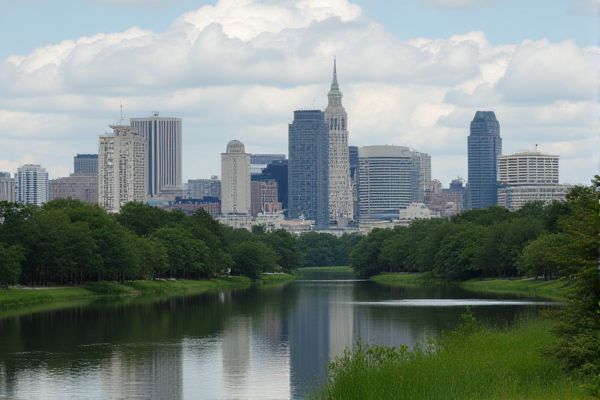
Transportation and commuting in Wisconsin: Extensive road network for cars. Milwaukee Public Transit: Buses and streetcars. Madison Metro: Reliable bus service. Bike-friendly cities and trails. Limited subway or light rail. Access to Amtrak services. Varied rural and urban transit options. Seasonal weather affects driving conditions. Carpool and vanpool options available. Rideshare services like Uber and Lyft.
Extensive road network for cars.
Wisconsin boasts an extensive road network featuring over 101,548 miles of local roads, which include county trunk highways, urban streets, and rural roads. These roads play a crucial role in connecting homes, businesses, and schools within communities, and link them to the larger state and national highway systems. However, the quality of these roads has unfortunately declined by 6.8% since 2010. For an in-depth analysis of this issue, you can explore the full report, "Assessing the Quality of Wisconsin's Local Roads," available at the Wisconsin Policy Forum.
Milwaukee Public Transit: Buses and streetcars.
Milwaukee's public transit system is centered around the Milwaukee County Transit System, which operates an extensive network of 42 bus routes with 360 buses. This service efficiently connects Milwaukee, Ozaukee, and Waukesha counties. Additionally, the city's transit offerings are supplemented by The Hop, a streetcar system featuring the M-Line and L-Line. These lines link downtown Milwaukee, the Lower East Side, and the Historic Third Ward. For those interested in learning more about this pivotal component of Milwaukee's public transportation, the Milwaukee County Transit System plans future extensions and even a temporary combined "F-Line" service to accommodate summer events, enhancing connectivity and ensuring passengers have versatile travel options.
Madison Metro: Reliable bus service.
Madison Metro Transit offers extensive bus services throughout Madison, Wisconsin, and its suburbs but is currently experiencing reliability issues due to equipment shortages and technical problems with its electric bus fleet, particularly affecting routes A and B. Despite these challenges, the service includes fare-free routes for UW-Madison students and faculty, paratransit services, and connections to suburban areas. There are ongoing efforts to resolve the disruptions and improve service reliability. To learn more about their services and initiatives, visit their website at Madison Metro Transit.
Bike-friendly cities and trails.
Wisconsin boasts several bike-friendly cities, including Madison, known for its platinum-standard bike infrastructure and trails like the Capital City Trail and Badger State Trail; Milwaukee, with over 85 miles of bike lanes and the Oak Leaf Trail; La Crosse, offering scenic rides along the Mississippi River and mountain bike trails; and Wausau, featuring marked bike routes and the Mountain-Bay State Trail. These cities are equipped with bike share programs, dedicated bike lanes, and extensive trail networks, making them ideal for both commuters and recreational cyclists. To explore these vibrant trails and routes, you can visit Wisconsin's Bike-Friendly Cities online.
Limited subway or light rail.
In Wisconsin, particularly in Milwaukee, there is no subway or light rail system; instead, the city relies on an extensive network of buses, including the Milwaukee County Transit System (MCTS) and the new Connect 1 Bus Rapid Transit Line (BRT), as well as other transportation options like bike share programs and ride-sharing services. For more detailed information on transportation options in Milwaukee, you can visit the Visit Milwaukee website.
Access to Amtrak services.
Wisconsin is served by three Amtrak routes, including the Hiawatha Service, Empire Builder, and Thruway motorcoach connections, which provide access to additional communities through combinations of rail and bus services, with key connections available at the Milwaukee Intermodal Station and other designated stations. Tickets and route information can be obtained through the Amtrak Website or by calling 1-800-USA-RAIL.
Varied rural and urban transit options.
Wisconsin offers a diverse range of rural and urban transit options, including bus systems like Valley Transit in Appleton and Metro in Green Bay, shared-ride taxi services such as those in Neillsville and Waupaca, ferry services like the Madeline Island Ferry Line, and specialized transit programs supported by federal and state funding to ensure connectivity across urban and rural areas. For more detailed information, you can explore a comprehensive collection of resources on the APTA website, which provides insights on the public transportation links available across the state.
Seasonal weather affects driving conditions.
Seasonal weather in Wisconsin significantly impacts driving conditions, with winter bringing snow, ice, and sleet that reduce road friction and visibility. Meanwhile, summer months see increased fatal crashes due to higher traffic volumes and faster speeds, despite generally better weather conditions. For a deeper dive into how these seasonal changes affect driving safety, visit the Wisconsin Seasonal Driving Study to learn more.
Carpool and vanpool options available.
In Wisconsin, especially at UW-Madison, individuals can take advantage of carpool and vanpool options through programs like Commute with Enterprise, which provides shared rides for groups of four to fifteen commuters. These programs offer significant benefits, including reduced parking costs, access to Emergency Ride Home services, and opportunities for tax-free transit accounts. For UW employees, carpool programs enable groups of three or more to share rides, further offering advantages such as split parking costs and daily parking passes. Notably, ride matching services are conveniently available through RoundTrip, facilitating easier participation in these shared commuting solutions.
Rideshare services like Uber and Lyft.
Rideshare services like Uber and Lyft are widely available in Wisconsin, including cities like Appleton and Milwaukee, offering various service levels such as standard, luxury, and carpool options. These services are accessible through mobile apps and are available at major transportation hubs like airports and train stations.
